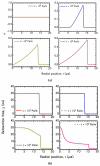Advanced Constitutive Modeling of the Thixotropic Elasto-Visco-Plastic Behavior of Blood: Steady-State Blood Flow in Microtubes
- PMID: 33451107
- PMCID: PMC7828603
- DOI: 10.3390/ma14020367
Advanced Constitutive Modeling of the Thixotropic Elasto-Visco-Plastic Behavior of Blood: Steady-State Blood Flow in Microtubes
Abstract
The present work focuses on the in-silico investigation of the steady-state blood flow in straight microtubes, incorporating advanced constitutive modeling for human blood and blood plasma. The blood constitutive model accounts for the interplay between thixotropy and elasto-visco-plasticity via a scalar variable that describes the level of the local blood structure at any instance. The constitutive model is enhanced by the non-Newtonian modeling of the plasma phase, which features bulk viscoelasticity. Incorporating microcirculation phenomena such as the cell-free layer (CFL) formation or the Fåhraeus and the Fåhraeus-Lindqvist effects is an indispensable part of the blood flow investigation. The coupling between them and the momentum balance is achieved through correlations based on experimental observations. Notably, we propose a new simplified form for the dependence of the apparent viscosity on the hematocrit that predicts the CFL thickness correctly. Our investigation focuses on the impact of the microtube diameter and the pressure-gradient on velocity profiles, normal and shear viscoelastic stresses, and thixotropic properties. We demonstrate the microstructural configuration of blood in steady-state conditions, revealing that blood is highly aggregated in narrow tubes, promoting a flat velocity profile. Additionally, the proper accounting of the CFL thickness shows that for narrow microtubes, the reduction of discharged hematocrit is significant, which in some cases is up to 70%. At high pressure-gradients, the plasmatic proteins in both regions are extended in the flow direction, developing large axial normal stresses, which are more significant in the core region. We also provide normal stress predictions at both the blood/plasma interface (INS) and the tube wall (WNS), which are difficult to measure experimentally. Both decrease with the tube radius; however, they exhibit significant differences in magnitude and type of variation. INS varies linearly from 4.5 to 2 Pa, while WNS exhibits an exponential decrease taking values from 50 mPa to zero.
Keywords: CFL; aggregation; amp; blood flow; blood thixotropy; blood viscoelasticity; fåhraeus effect; hemodynamics; interfacial shear & microtubes; normal stresses; personalized hemorheology; plasma viscoelasticity; relaxation time; rouleaux; wall shear &.
Conflict of interest statement
The authors declare no conflict of interest.
Figures


























Similar articles
-
Shear stress and intravascular pressure effects on vascular dynamics: two-phase blood flow in elastic microvessels accounting for the passive stresses.Biomech Model Mechanobiol. 2022 Dec;21(6):1659-1684. doi: 10.1007/s10237-022-01612-2. Epub 2022 Aug 12. Biomech Model Mechanobiol. 2022. PMID: 35962247
-
Advanced Constitutive Modeling of the Thixotropic Elasto-Visco-Plastic Behavior of Blood: Description of the Model and Rheological Predictions.Materials (Basel). 2020 Sep 20;13(18):4184. doi: 10.3390/ma13184184. Materials (Basel). 2020. PMID: 32962308 Free PMC article.
-
Dynamics of blood flow: modeling of Fåhraeus and Fåhraeus-Lindqvist effects using a shear-induced red blood cell migration model.J Biol Phys. 2018 Dec;44(4):591-603. doi: 10.1007/s10867-018-9508-5. Epub 2018 Sep 15. J Biol Phys. 2018. PMID: 30219980 Free PMC article.
-
Recent advances in blood rheology: a review.Soft Matter. 2021 Dec 8;17(47):10591-10613. doi: 10.1039/d1sm01212f. Soft Matter. 2021. PMID: 34787149 Review.
-
Blood viscosity in tube flow: dependence on diameter and hematocrit.Am J Physiol. 1992 Dec;263(6 Pt 2):H1770-8. doi: 10.1152/ajpheart.1992.263.6.H1770. Am J Physiol. 1992. PMID: 1481902 Review.
Cited by
-
Numerical analysis of blood flow through stenosed microvessels using a multi-phase model.Heliyon. 2024 Apr 21;10(9):e29843. doi: 10.1016/j.heliyon.2024.e29843. eCollection 2024 May 15. Heliyon. 2024. PMID: 38694061 Free PMC article.
References
-
- Pries A.R., Secomb T.W. Rheology of the Microcirculation. Clin. Hemorheol. Microcirc. 2003;29:143–148. - PubMed
LinkOut - more resources
Full Text Sources
Other Literature Sources

